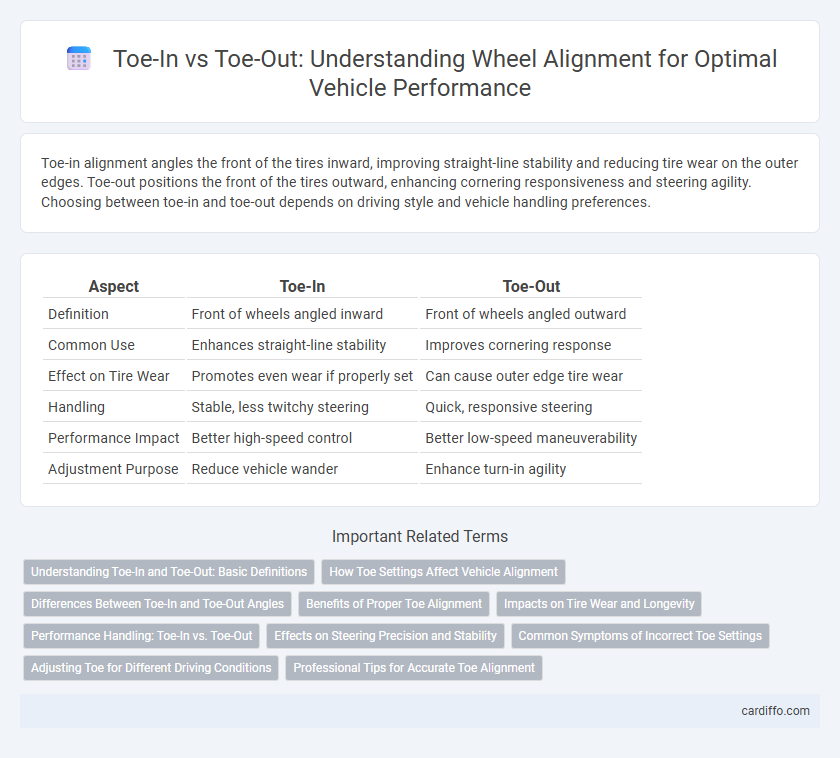Toe-in alignment angles the front of the tires inward, improving straight-line stability and reducing tire wear on the outer edges. Toe-out positions the front of the tires outward, enhancing cornering responsiveness and steering agility. Choosing between toe-in and toe-out depends on driving style and vehicle handling preferences.
Table of Comparison
| Aspect | Toe-In | Toe-Out |
|---|---|---|
| Definition | Front of wheels angled inward | Front of wheels angled outward |
| Common Use | Enhances straight-line stability | Improves cornering response |
| Effect on Tire Wear | Promotes even wear if properly set | Can cause outer edge tire wear |
| Handling | Stable, less twitchy steering | Quick, responsive steering |
| Performance Impact | Better high-speed control | Better low-speed maneuverability |
| Adjustment Purpose | Reduce vehicle wander | Enhance turn-in agility |
Understanding Toe-In and Toe-Out: Basic Definitions
Toe-in refers to wheel alignment where the front edges of the tires are closer together than the rear edges, causing the wheels to point slightly inward. Toe-out is the opposite condition, with the front edges of the tires farther apart than the rear edges, making the wheels point outward. Proper toe settings enhance vehicle stability, tire wear, and handling performance.
How Toe Settings Affect Vehicle Alignment
Toe-in and toe-out settings critically influence vehicle alignment by altering tire angle relative to the centerline, impacting handling and tire wear. Proper toe-in enhances straight-line stability by slightly angling the front of the tires inward, while toe-out improves cornering response by angling them outward. Incorrect toe settings cause uneven tire wear, reduced fuel efficiency, and compromised steering precision, emphasizing the importance of precise adjustment for optimal alignment performance.
Differences Between Toe-In and Toe-Out Angles
Toe-in occurs when the front edges of the tires point slightly toward the vehicle's centerline, enhancing straight-line stability and reducing tire wear on the outer edges. Toe-out features the front edges of the tires angled away from the centerline, improving cornering response and steering agility but increasing inner tire wear. The differences between toe-in and toe-out angles significantly impact vehicle handling characteristics, tire wear patterns, and alignment tuning depending on driving conditions and performance requirements.
Benefits of Proper Toe Alignment
Proper toe alignment enhances vehicle stability by ensuring tires maintain optimal contact with the road surface. Correct toe settings reduce uneven tire wear, extending tire lifespan and improving fuel efficiency. Precise toe adjustment also contributes to safer handling, minimizing steering issues and enhancing overall driving comfort.
Impacts on Tire Wear and Longevity
Toe-in alignment causes the tires to point slightly inward, increasing inner edge tire wear and reducing tire longevity due to uneven friction distribution. Toe-out alignment results in tires angling outward, leading to excessive outer edge wear and quicker degradation of tire tread life. Proper alignment settings optimize tire contact with the road, minimizing irregular wear patterns and extending overall tire lifespan.
Performance Handling: Toe-In vs. Toe-Out
Toe-in alignment enhances straight-line stability and reduces oversteer by angling the front of the tires inward, improving traction during high-speed cornering. Toe-out promotes quicker steering response and increased agility by angling the front of the tires outward, benefiting vehicles that require sharp handling in tight turns. Optimizing toe settings depends on vehicle type, driving conditions, and performance goals to balance grip, tire wear, and responsiveness.
Effects on Steering Precision and Stability
Toe-in alignment, where the front of the tires point slightly toward each other, enhances straight-line stability and reduces sensitivity to road imperfections, improving steering precision on highways. Toe-out alignment, with the front of the tires pointing away from each other, increases responsiveness during cornering but can cause twitchy steering and reduced stability at higher speeds. Optimizing toe settings is essential for balancing precise steering input with overall vehicle stability, tailored to driving conditions and performance needs.
Common Symptoms of Incorrect Toe Settings
Incorrect toe-in settings often cause excessive inner tire wear, leading to decreased tire life and unstable vehicle handling. Toe-out misalignment commonly results in outer tire tread wear, poor straight-line stability, and increased steering sensitivity. Both conditions contribute to uneven tire wear patterns, compromised fuel efficiency, and reduced overall driving safety.
Adjusting Toe for Different Driving Conditions
Adjusting toe settings optimizes vehicle handling and tire wear under various driving conditions. Toe-in enhances straight-line stability by angling the front of the tires inward, ideal for high-speed cruising and highway driving. Toe-out improves cornering response and agility by angling the front of the tires outward, beneficial for aggressive steering and tight cornering scenarios.
Professional Tips for Accurate Toe Alignment
Professional tips for accurate toe alignment emphasize the importance of precise measurements using advanced alignment tools like laser or optical systems to detect small deviations. Technicians should ensure the vehicle is on a level surface and tires are properly inflated before adjusting toe-in or toe-out angles to factory specifications. Regular calibration of alignment equipment and adherence to manufacturer guidelines enhance the accuracy of toe settings and improve vehicle handling and tire longevity.
Toe-in vs toe-out Infographic

 cardiffo.com
cardiffo.com